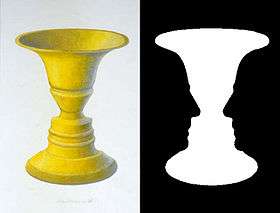Rubin vase
Rubin's vase (sometimes known as the Rubin face or the figure–ground vase) is a famous set of ambiguous or bi-stable (i.e., reversing) two-dimensional forms developed around 1915 by the Danish psychologist Edgar Rubin. They were first introduced at large in Rubin's two-volume work, the Danish-language Synsoplevede Figurer ("Visual Figures"), which was very well received; Rubin included a number of examples, such as a Maltese cross figure in black and white, but the one that became the most famous was his vase example, perhaps because the Maltese cross could also be easily interpreted as a black and white beachball.

Rubin presented in his doctoral thesis (1915) a detailed description of the visual figure-ground relationship, an outgrowth of the visual perception and memory work in the laboratory of his mentor, Georg Elias Müller.[1] One element of Rubin's research may be summarized in the fundamental principle, "When two fields have a common border, and one is seen as figure and the other as ground, the immediate perceptual experience is characterized by a shaping effect which emerges from the common border of the fields and which operates only on one field or operates more strongly on one than on the other".[2]
The effect
The visual effect generally presents the viewer with two shape interpretations, each of which is consistent with the retinal image, but only one of which can be maintained at a given moment. This is because the bounding contour will be seen as belonging to the figure shape, which appears interposed against a formless background. If the latter region is interpreted instead as the figure, then the same bounding contour will be seen as belonging to it.
Explanation

These types of stimuli are both interesting and useful because they provide an excellent and intuitive demonstration of the figure–ground distinction the brain makes during visual perception. Rubin's figure–ground distinction, since it involved higher-level cognitive pattern matching, in which the overall picture determines its mental interpretation, rather than the net effect of the individual pieces, influenced the Gestalt psychologists, who discovered many similar percepts themselves.
Normally the brain classifies images by which object surrounds which – establishing depth and relationships. If one object surrounds another object, the surrounded object is seen as figure, and the presumably further away (and hence background) object is the ground, and vice versa. This makes sense, since if a piece of fruit is lying on the ground, one would want to pay attention to the "figure" and not the "ground".[3] However, when the contours are not so unequal, ambiguity starts to creep into the previously simple inequality, and the brain must begin "shaping" what it sees; it can be shown that this shaping overrides and is at a higher level than feature recognition processes that pull together the face and the vase images – one can think of the lower levels putting together distinct regions of the picture (each region of which makes sense in isolation), but when the brain tries to make sense of it as a whole, contradictions ensue, and patterns must be discarded.
Construction

The distinction is exploited by devising an ambiguous picture, whose contours match seamlessly the contours of another picture (sometimes the same picture; a practice M.C. Escher used on occasion). The picture should be "flat" and have little (if any) texture to it. The stereotypical example has a vase in the center, and a face matching its contour (since it is symmetrical, there is a matching face on the other side).
See also
References
Further reading
- A Psychology of Picture Perception, John M. Kennedy. 1974, Jossey-Bass Publishers, ISBN 0-87589-204-3
- The art and science of visual illusions, Nicholas Wade. 1982 Routledge & Kegan Paul Ltd. ISBN 0-7100-0868-6
- Visual Space Perception, William H. Ittelson. 1969, Springer Publishing Company, LOCCCN 60-15818
- "Vase or face? A neural correlates of shape-selective grouping processes in the human brain." Uri Hasson, Talma Hendler, Dafna Ben Bashat, Rafael Malach.
- Journal of Cognitive Neuroscience, Vol 13(6), Aug 2001. pp. 744–753. ISSN 0898-929X (Print)
External links
| Wikimedia Commons has media related to Rubin's vase. |
- Rubin's People Inside the Wall People trapped inside a Wall
- Illusionworks.com article
- Rubin has invented nothing The Rubin's vase before Rubin (fr)